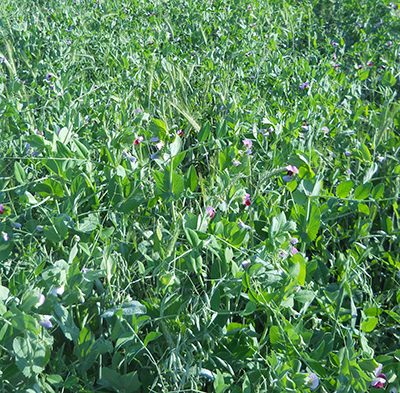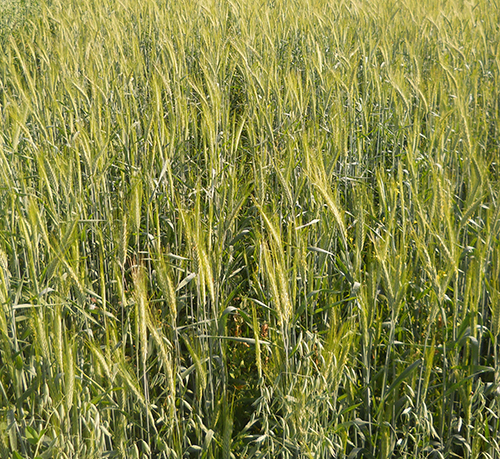Alfalfa nurse crop yields compared
Yields of various nurse crops and seeding rates show significant differences. Impact on alfalfa stand remains to be measured.

Small grain and small grain/forage pea nurse crops were removed from the alfalfa nurse crop trial at the Michigan State University Upper Peninsula Research and Extension Center in Chatham, Michigan, on July 10, 2018. The oat nurse crop was in early milk stage. Ideally, the nurse crops would have been removed in the boot stage. The harvest date was later than ideal with regard to alfalfa establishment by a week or more, but resulted in high forage yield. This MSU Extension trial, funded by Project GREEEN, is intended to take a look at the impact of various alfalfa nurse crops at different seeding rates on the resulting alfalfa establishment.
Alfalfa stand counts will be taken this fall and again in spring, along with alfalfa yield checks. The nurse crop forage yield is an important part of the project, but secondary to the nurse crop impact on alfalfa stand establishment.
Nineteen different nurse crop treatments are being tested, including “no nurse crop.”
|
Table 1. Alfalfa nurse crop seeding rates. |
|||
|
Nurse crop |
Low seeding rate (pounds per acre) |
Medium seeding rate (pounds per acre) |
High seeding rate (pounds per acre) |
|
Control (no nurse crop) |
0 |
0 |
0 |
|
Goliath oats |
16 |
32 |
48 |
|
Goliath oats + 4010 peas (50% by weight) |
50 |
75 |
100 |
|
Kewaunee barley |
24 |
48 |
72 |
|
Silobuster Plus barley + peas |
50 |
75 |
100 |
|
Spring triticale |
25 |
50 |
75 |
|
Silobuster Plus triticale + peas |
50 |
75 |
100 |
The nurse crops were drilled into disked ground with the Center’s JD 1590 No Till planter on May 14 and 15. Eighteen pounds per acre of Alforex 469 alfalfa was planted over top with a Brillion seeder on May 15. Urea was applied at 150 pounds per acre on May 19.
Average nurse crop yields are as follows.
|
Table 2. Average nurse crop yields. |
||
|
Nurse crop |
Seeding rate |
Yield (tons dry matter per acre) |
|
None |
None |
0.63 |
|
Kewaunee barley |
Low |
1.53 |
|
Kewaunee barley |
Medium |
2.00 |
|
Kewaunee barley |
High |
2.00 |
|
Goliath oat |
Low |
1.47 |
|
Goliath oat |
Medium |
2.02 |
|
Goliath oat |
High |
1.93 |
|
Triticale |
Low |
1.26 |
|
Triticale |
Medium |
1.42 |
|
Triticale |
High |
1.72 |
|
Goliath oat plus 4010 peas |
Low |
2.09 |
|
Goliath oat plus 4010 peas |
Medium |
2.20 |
|
Goliath oat plus 4010 peas |
High |
2.36 |
|
Silobuster barley plus 4010 peas |
Low |
1.74 |
|
Silobuster barley plus 4010 peas |
Medium |
1.97 |
|
Silobuster barley plus 4010 peas |
High |
2.02 |
|
Silobuster triticale plus 4010 peas |
Low |
1.49 |
|
Silobuster triticale plus 4010 peas |
Medium |
1.48 |
|
Silobuster triticale plus 4010 peas |
High |
1.73 |

It should be noted that plot yield where no nurse crop was seeded consisted mostly of weed growth.
The average yields of each nurse crop including all seeding rates suggest a forage yield advantage with oats or barley over triticale when seeded without peas. When peas are included, oats plus peas had the best yield, followed by barley plus peas and triticale plus peas:
- Triticale: 1.47 tons dry matter per acre
- Triticale + peas: 1.57 tons dry matter per acre
- Oats: 1.81 tons dry matter per acre
- Oats + peas: 2.21 tons dry matter per acre
- Barley: 1.82 tons dry matter per acre
- Barley + peas: 1.91 tons dry matter per acre
When average yields of small grains at all seeding rates are compared with small grain/pea combinations at all seeding rates, the results suggest little yield difference when peas are included:
- With peas: 1.90 tons dry matter per acre
- Without peas: 1.70 tons dry matter per acre

Results of other university trials support the idea that although addition of forage peas may not improve yield significantly, it can improve forage protein content. “Pea and small grain mixtures” from University of Wisconsin Extension provides more detail.
Alfalfa stand results from this project will be published on the MSU Extension News for Forages website in spring 2019. Please contact Jim Isleib, Extension educator, at isleibj@anr.msu.edu with any questions.



 Print
Print Email
Email